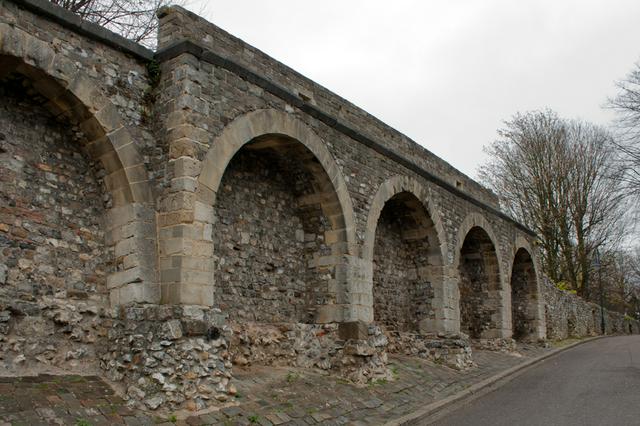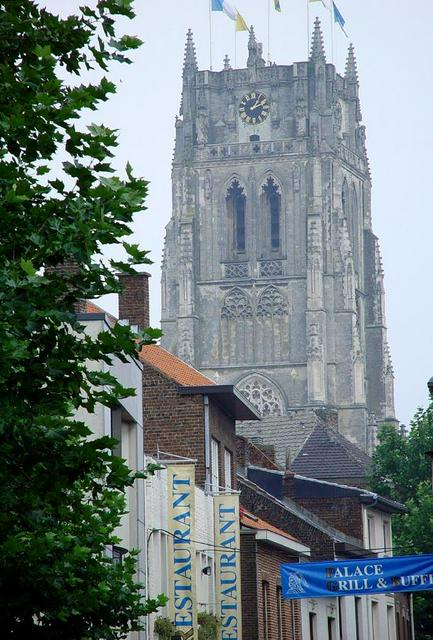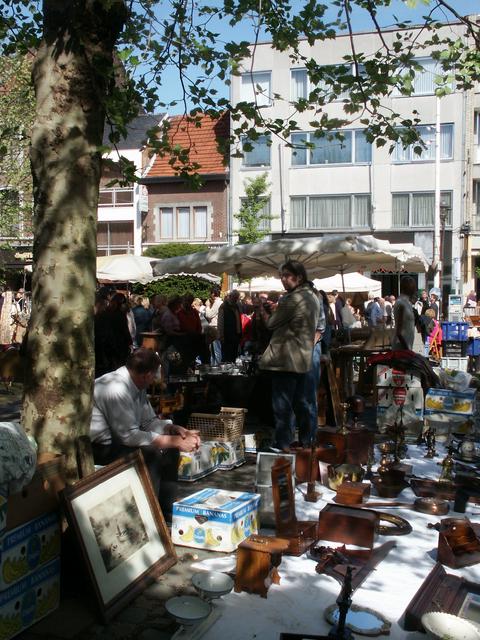Tongeren (French: Tongres, German: Tongern) is a city and municipality located in the province of Limburg in the Flemish region of Belgium.
The city is the capital of both an administrative and a judicial district. The municipality has 30,000 inhabitants in an area of 87.56 km ². 17,000 people live in the old town. The slogan oldest town in Belgium as well as the famous Sunday antique and flea market make the city a popular tourist attraction.
 Tongeren is located on ancient crossroads and finds probably its origin in the military camp Atuatuca Tungrorum. The settlement was the administrative centre of the district Tungri under Roman rule, which makes it the oldest town of Belgium.
Christianity made its appearance during the arrival of St. Marternus who converted the region. At the end of the fourth century, the city was destroyed by the Alans and in 450 BC again by the Huns. St. Gongulfus rebuilt the city in 600 BC. During the Middle Ages Tongeren was an important city in the diocese of Liege. Unfortunately, the city was involved in many regional wars during that time. The great city fire in 1677, deliberately caused by French troops, was a sad bottom. Between 1794 and 1814 Tongeren was again occupied by French armies. In 1815 it became part of the province of Limburg within the United Kingdom of the Netherlands. After the separation of Belgium in 1830 Tongeren became part of the Belgian province of Limburg.
Tongeren is located on ancient crossroads and finds probably its origin in the military camp Atuatuca Tungrorum. The settlement was the administrative centre of the district Tungri under Roman rule, which makes it the oldest town of Belgium.
Christianity made its appearance during the arrival of St. Marternus who converted the region. At the end of the fourth century, the city was destroyed by the Alans and in 450 BC again by the Huns. St. Gongulfus rebuilt the city in 600 BC. During the Middle Ages Tongeren was an important city in the diocese of Liege. Unfortunately, the city was involved in many regional wars during that time. The great city fire in 1677, deliberately caused by French troops, was a sad bottom. Between 1794 and 1814 Tongeren was again occupied by French armies. In 1815 it became part of the province of Limburg within the United Kingdom of the Netherlands. After the separation of Belgium in 1830 Tongeren became part of the Belgian province of Limburg.
- Tourist office Tongeren, Via Julianus 5 (Julianus Shopping Tongeren, entrance De Schiervelstraat, +32 12 800070. In summer daily 08:30-12:00 13:00-17:00.
Tourist office Tongeren, Via Julianus 5 (Julianus Shopping Tongeren, entrance De Schiervelstraat, +32 12 800070. In summer daily 08:30-12:00 13:00-17:00.

- Basilica of Our Lady, Grote Markt, +32 12 39 40 34. Apr.-Sept., M 13:30-17:00, Tu-Su 10:00-12:00 and 13:30-17:00. One of the most beautiful medieval monuments in the world. Built in Gothic style in the 13th century, where recent excavations have produced some of the richest archaeological finds in Flanders. Archaeological excavations have proven the presence of an edifice here starting from the 4th century, while a Carolingian prayer house existed here in the 9th century. The building of the choir of the present basilica began in 1240. Nave, transepts and side chapels were added between the 13th and 15th century. The original Romanesque tower was replaced by the present, 64 meters tall Gothic tower from 1442 until 1541. The basilica's interior is home to the statue of Our Lady of Tongeren, executed in 1475. The treasury is housed in the former hall of the Chapter and comprises one of the richest collections of religious art in Belgium. The basilica has excellent acoustics and is often used for symphony concerts. €2.50 for treasury.
- Statue of Ambiorix, Grote Markt. The fearsome leader of the Eburons, which was a tribe that defeated two of Caesar's legions in 54 B.C. Nowadays Ambiorix is one of the most famous characters in Belgian history.
- Roman Walls. The original Roman wall, dating from the 2nd century, still visible on more than 1,500 meters. You will also notice some of the medieval defensive towers that are still visible today.
- St. Catherina's Béguinage. The béguinage is founded in 1257 and is one of the oldest in Flanders. In the second half of the 16th century escalated the rivalry between Catholics and Protestants in which the possessions of the Beguines were looted and destroyed. In the 17th century the béguinage came to an unprecedented boom and the Beguines became wealthy. The wooden houses were replaced by stone ones. Its heyday was at the beginning of the 18th century. The béguinage counted nearly 100 homes and more than 300 Beguines. In the 19th century it was opened up and became a whole with the rest of the town. Since 1998 it is listed as a UNESCO World Heritage Site.
- Romeinse kloostergang. On the east side of the basilica is the Romanesque cloister from the 12th century. This was enlarged in the early 13th century and rebuilt in its present form. The vertically placed tombstones, as well as the corner chapels on the east side, dating from later periods. Between the cloister and the entrance to the church is a Romanesque statue of Christ from the 11th century.
- Town hall and belfry. The town hall is built between 1737 and 1750 in classical style. It is not open to visitors, but the belfry tower is a .
Basilica of Our Lady, Grote Markt, +32 12 39 40 34. Apr.-Sept., M 13:30-17:00, Tu-Su 10:00-12:00 and 13:30-17:00. One of the most beautiful medieval monuments in the world. Built in Gothic style in the 13th century, where recent excavations have produced some of the richest archaeological finds in Flanders. Archaeological excavations have proven the presence of an edifice here starting from the 4th century, while a Carolingian prayer house existed here in the 9th century. The building of the choir of the present basilica began in 1240. Nave, transepts and side chapels were added between the 13th and 15th century. The original Romanesque tower was replaced by the present, 64 meters tall Gothic tower from 1442 until 1541. The basilica's interior is home to the statue of Our Lady of Tongeren, executed in 1475. The treasury is housed in the former hall of the Chapter and comprises one of the richest collections of religious art in Belgium. The basilica has excellent acoustics and is often used for symphony concerts. €2.50 for treasury.
Statue of Ambiorix, Grote Markt. The fearsome leader of the Eburons, which was a tribe that defeated two of Caesar's legions in 54 B.C. Nowadays Ambiorix is one of the most famous characters in Belgian history.
Roman Walls. The original Roman wall, dating from the 2nd century, still visible on more than 1,500 meters. You will also notice some of the medieval defensive towers that are still visible today.
St. Catherina's Béguinage. The béguinage is founded in 1257 and is one of the oldest in Flanders. In the second half of the 16th century escalated the rivalry between Catholics and Protestants in which the possessions of the Beguines were looted and destroyed. In the 17th century the béguinage came to an unprecedented boom and the Beguines became wealthy. The wooden houses were replaced by stone ones. Its heyday was at the beginning of the 18th century. The béguinage counted nearly 100 homes and more than 300 Beguines. In the 19th century it was opened up and became a whole with the rest of the town. Since 1998 it is listed as a UNESCO World Heritage Site.
Romeinse kloostergang. On the east side of the basilica is the Romanesque cloister from the 12th century. This was enlarged in the early 13th century and rebuilt in its present form. The vertically placed tombstones, as well as the corner chapels on the east side, dating from later periods. Between the cloister and the entrance to the church is a Romanesque statue of Christ from the 11th century.
Town hall and belfry. The town hall is built between 1737 and 1750 in classical style. It is not open to visitors, but the belfry tower is a .
 Visit the antique and flea market on Sunday morning. It is the largest antique market of the Benelux. The market is open from 6:00 until 13:00. Go there as early as possible to increase your chance obtaining unique stuff.
Visit the antique and flea market on Sunday morning. It is the largest antique market of the Benelux. The market is open from 6:00 until 13:00. Go there as early as possible to increase your chance obtaining unique stuff.
- Beghina, Onder de Linde 12, +32 12 213259. Tue-Sat 10:00-12:00 13:30-16:30, Sun 13:00-17:00. The museum is located in an authentic Beguine house that dates from 1660. €3.50.
- Provinciaal Gallo-Romeins Museum, Kielenstraat 15, +32 12 670332. Tu-F 9:00—17:00, weekends 10:00—18:00. Closed on M, unless it is a holiday. Houses Celtic gold, Roman glassware, Merovingian filigree work, and the dodecahedron (12-facet ball), an unusual Gallo-Roman object found during excavations which nobody knows what it represents or was used for. €7, €1 for people younger than 26.
- Moerenpoort, +32 12 800070. In summer Wed-Sat 13:00-17:00, Sun 9:30-12:00 13:00-17:00. In winter only on Sunday.. The Moerenpoort (Moeren Gate or Tower) is the only remaining medieval city gate. The gate is recently restored and is open to the public.
Beghina, Onder de Linde 12, +32 12 213259. Tue-Sat 10:00-12:00 13:30-16:30, Sun 13:00-17:00. The museum is located in an authentic Beguine house that dates from 1660. €3.50.
Provinciaal Gallo-Romeins Museum, Kielenstraat 15, +32 12 670332. Tu-F 9:00—17:00, weekends 10:00—18:00. Closed on M, unless it is a holiday. Houses Celtic gold, Roman glassware, Merovingian filigree work, and the dodecahedron (12-facet ball), an unusual Gallo-Roman object found during excavations which nobody knows what it represents or was used for. €7, €1 for people younger than 26.
Moerenpoort, +32 12 800070. In summer Wed-Sat 13:00-17:00, Sun 9:30-12:00 13:00-17:00. In winter only on Sunday.. The Moerenpoort (Moeren Gate or Tower) is the only remaining medieval city gate. The gate is recently restored and is open to the public.
If you visit the town during a weekend, don't forget to visit the Antique and flea market. If not, don't panic as there are plenty antique and brocante shops in Tongeren. You will find some around the Leopoldswal.
- AntiquesMarket, Main squares. Sunday starting at 6AM. The selection of antiques and brocante (vintage goods and collectibles) draws people from all over the country.
- Julianus Shopping, Maastrichterstraat/Via Julianus, +32 12 635270. Mon-Thu and Sat 10:00-18:00, First Sunday of the month 11:00-17:00. This shopping center with an area of 7795 sqm accommodates 24 shops.
AntiquesMarket, Main squares. Sunday starting at 6AM. The selection of antiques and brocante (vintage goods and collectibles) draws people from all over the country.
Julianus Shopping, Maastrichterstraat/Via Julianus, +32 12 635270. Mon-Thu and Sat 10:00-18:00, First Sunday of the month 11:00-17:00. This shopping center with an area of 7795 sqm accommodates 24 shops.
- De Mijlpaal, Sint-Truidenstraat 25, +32 12 26 42 77. Mo, Th, F, Su 12:00-14:00 19:00-21:00. Sa 19:00-21:00. €75 Mijlpaal menu.
- Bazilik, Kloosterstraat 1, +32 12 21 33 24. Daily from 10:00, Th from 9:00. €35 three course menu.
- Ambiotel, Veemarkt 2, +32 12 26 29 50. Daily 09:00-23:00. €10 for the dish of the day.
- Infirmerie, St. Ursulastraat 11, +32 12 44 10 44. W-Sa 11:30-22:00, Su 9:30-22:00. €40 three course menu.
De Mijlpaal, Sint-Truidenstraat 25, +32 12 26 42 77. Mo, Th, F, Su 12:00-14:00 19:00-21:00. Sa 19:00-21:00. €75 Mijlpaal menu.
Bazilik, Kloosterstraat 1, +32 12 21 33 24. Daily from 10:00, Th from 9:00. €35 three course menu.
Ambiotel, Veemarkt 2, +32 12 26 29 50. Daily 09:00-23:00. €10 for the dish of the day.
Infirmerie, St. Ursulastraat 11, +32 12 44 10 44. W-Sa 11:30-22:00, Su 9:30-22:00. €40 three course menu.
You will find a lot of pubs and café on and around the Grote Markt square. Many offer snacks and even complete menus.
- Casque, Grote Markt 17, +32 12 213198. Grand café.
- 't Gerechtshof, Vrijthof 1, +32 12 742078.
- 't Sweert, De Schiervelstraat 3, +32 12 394242.
- 't Wit Paard, Sint-Truiderstraat 58, +32 12 239172.
- The Pub, Grote Markt 7, +32 12 23 93 02.
Casque, Grote Markt 17, +32 12 213198. Grand café.
't Gerechtshof, Vrijthof 1, +32 12 742078.
't Sweert, De Schiervelstraat 3, +32 12 394242.
't Wit Paard, Sint-Truiderstraat 58, +32 12 239172.
The Pub, Grote Markt 7, +32 12 23 93 02.
The Ardennes are close if you're looking for rest and beautiful nature. Liège, 30km south, is the main regional city and Belgium's third largest metropolis, after Brussels and Antwerp.
